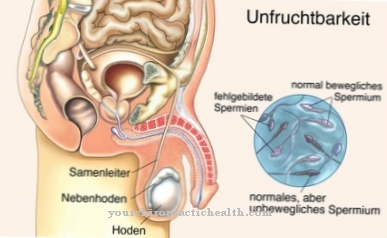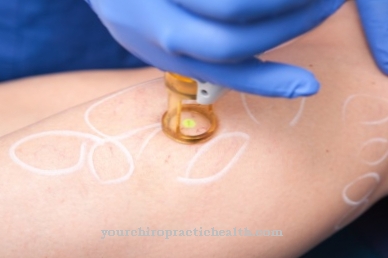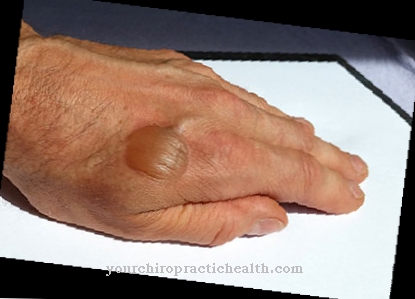With every third to fourth spontaneous birth, but also with forceps or suction cup births, a so-called occurs in the woman giving birth Perineal tear: During the expulsion phase, the pressure of the child stretches the tissue between the anus and the vagina so much that it can tear. This birth injury occurs in varying degrees and degrees of severity.
What is a perineal tear?

© Morphart - stock.adobe.com
The perineal tear is a birth injury feared by pregnant women, which can or does not have to occur during the birth of the child. The tearing of this sensitive perineal region is also divided into different degrees of severity, based on which the injury is classified by the treating doctor after delivery:
In the case of a first-degree perineal tear, only the upper layer of skin tears up to the middle of the perineum, so it does not reach the anus and spares the deeper muscle layers. The stronger vaginal tear of the muscle tissue up to shortly before the anus is called a second-degree perineal tear.
In the third degree, the entire perineum ruptures and includes the sphincter muscle. At the last and most distinct degree, the entire perineum, the sphincter and the anterior portions of the wall of the rectum tear.
causes
During the expulsion phase, also known as "pressure contractions", there is very strong downward pressure from the contractions of the uterus and the pressing of the mother.
During this phase, the entire weight of the baby presses on the woman's sensitive pelvic floor and exerts a pressure that is unusual for the sensitive perineal region. In the last phase of normal spontaneous delivery, the baby's head is born first, then its shoulder, and then the rest of its body.
The size of the head and body put a lot of pressure on the vaginal and perineal muscles and the vaginal outlet is stretched to its maximum. However, if it is overstretched, the tissue tears as described, with or without muscle involvement. Several perineal cracks can occur at the same time.
Symptoms, ailments & signs
Even weeks after the birth, complaints such as pain, burning or bleeding are still possible. If the perineal tear is not noticed and treated at birth, it often manifests itself in pain when walking, sitting or exercising. Slight bleeding may occur, which is often not recognized by the patient due to the natural bleeding.
Defecation and urination in particular can be very painful in the first few days after the birth and are often associated with a strong burning sensation. Even if the wound heals quickly, the skin can harden. Depending on the severity of the injury, this hardening can often be felt and even after it has healed, it can still cause pain during sexual activity or sport.
If the perineum itself is very painful and possibly accompanied by foul smelling urine, this could be a sign of a suture infection or a urinary tract infection. Hemorrhoids and abscesses can also form around the perineal suture, which are manifested by itching, pain and possibly slight bleeding. However, most of the signs and symptoms of a perineal tear disappear within the first few weeks after the birth.
Diagnosis & course
Based on the severity of this birth injury, the doctor can determine how many stitches are necessary to sew up. Immediately after delivery, after the newborn has been cut off, the woman's injury is sutured under local anesthesia.
If the birth took place under epidural anesthesia, the area to be sutured is no longer anaesthetized. At this point, it should be mentioned that the tearing of the perineum at the time of expulsion is perceived as more pleasant and relieving than painful for the woman in labor, as all the pressure is removed from her pelvis. The care for the injury is also done under the influence of the body's own hormones and is rarely perceived as seriously painful.
Complications
A perineal tear can lead to various complications. Depending on the degree of injury, harmless skin injuries or severe cracks in the sphincter muscle can occur, which are associated with pain, dysfunction and other complaints. Surgery can result in further injuries and infections in the area of the anus.
Risk patients also run the risk of circulatory shock and similar complications. As the wound heals, swelling and pain can occur. A sutured dam causes tension pain and other complaints a few days later. When going to the toilet, there may be burning pain and rarely the scar tearing open.
After the wound has healed, excessive scarring can occur, which leads to discomfort, especially during bowel movements and sexual intercourse. If the perineum is severely ruptured, abscesses can form, which require a new operation. Severe tears in the perineum can also cause fistulas between the vagina and the intestine.
An injured sphincter muscle can lead to temporary incontinence, which primarily affects the loss of diapers. The restricted muscle functions can cause functional complaints after a perineal tear, which must be treated with the help of pelvic floor training.
When should you go to the doctor?
A perineal tear arises in a direct connection to a birth. This should always be accompanied and supported by a doctor and / or a midwife. If the perineum ruptures outside of the birth process, this is considered unusual. If pain and discomfort in the anus occur when defecating or during sexual activities, they should be examined and clarified by a doctor. If the symptoms are too high or if they spread further, a doctor should be consulted so that the cause can be found out.
If bleeding occurs or there are open wounds in the region around the anus or the vaginal outlet, germs can enter the organism and trigger further diseases. For this reason, a doctor should be consulted so that the wounds can be treated sterile and closed. If you have a fever, itching, changes in the skin or a burning sensation on the skin, a doctor should be asked for advice. A doctor's visit is also necessary if there are problems with locomotion, while sitting or in a stooping posture.
If there is no bowel movement for more than two days, a medical examination must be initiated. Even with small tears in the skin near the perineum, a doctor should be consulted, as self-care of the wound can lead to complications.
Doctors & therapists in your area
Treatment & Therapy
The treatment of the perineal tear is carried out as described by directly suturing the wound. Some doctors decide to have a prophylactic perineal incision even during birth, but this is done less and less because the torn seams grow together and heal better than those caused by the scalpel.
Since the perineum and vaginal region are very stressed and the mucous membrane is involved, delays or difficulties can arise in the healing process. Sitting, walking or using the toilet constantly stretches and stresses the seam, so that the seam can tear again or impaired wound healing.
Hygiene is the top priority at this point, but also caution and patience. Mostly absorbable, i.e. self-dissolving sutures are used when sewing, which no longer have to be pulled extra. Nevertheless, the suture should be checked regularly by the gynecologist or the aftercare midwife for inflammation or other wound healing disorders.
Outlook & forecast
A tear in the perineum is easily curable with today's medical options. The procedure takes a few minutes and is considered routine treatment. The patient is usually released from treatment a few days or weeks after the corrective operation. Nevertheless, lifelong complications or impairments can occur.
Since the perineal tear is sewn, there is a risk of unwanted scarring. In some cases, this leads to problems with bowel movements or sexual intercourse. To improve wellbeing, the patient can take various measures that are helpful and relieving in everyday life.
Avoid pressing hard when using the toilet. Nutrition and hygiene can be optimized. Short, lukewarm hip baths are perceived as pleasant and healing. If the measures taken are not sufficient, the patient can have the scarring treated in further therapy. The prognosis in these cases is individual and depends on the intensity of the existing scars.
However, a deterioration is considered to be rather unlikely. As a long-term consequence, a tear in the perineum can lead to increased inflammation. These are considered uncomfortable, but are also easy to treat. In unfavorable cases, a colonoscopy, enemas or other intestinal examinations are difficult due to the long-term effects of the perineal tear. This is particularly unfortunate when it comes to cancer screening.
prevention
To prevent a perineal tear, a perineal massage with a suitable oil can be performed during the last few weeks of pregnancy. There are various techniques in which the thumb is usually inserted into the vagina about as deep as a pad and gently massaged from the anus towards the vagina with the index finger. A regular massage can soften the tissue and thus better prepare for the pressure during childbirth.
Aftercare
Due to the perineal tear and the subsequent sewing of the same, the tissue is irritated and swells up considerably. To prevent this, patients are given decongestant medication immediately.
Cooling the area with special cooling gels or cool packs also causes swelling and relieves pain. Midwives also recommend freezing templates soaked in cooking oil and using them instead of gel or cool packs. The cold effect achieved in this way is perceived as more pleasant and at the same time has a caring effect on the skin.
Some sufferers prefer healing Sitz baths made of warm water with special bath additives or healing plant extracts instead. However, the baths should only be used once a day for about ten to fifteen minutes to avoid softening of the wound and an increased tendency to swell.
It is extremely important to observe a closed period of at least five days, during which those affected should not sit or walk if possible. When going to the toilet, small triple steps are recommended, in which the wound is not stretched and strained.
There are a few things to consider when using the toilet. Increasing the amount of fluid dilutes the urine and reduces the burning sensation when urinating. In the meantime, those affected can pour lukewarm water from a glass between their legs in order to achieve further dilution and to minimize the pain.
You can do that yourself
In order for a perineal tear to heal well, the seam should not be heavily stressed. A lot of air should get to the fresh wound and the seam area should be kept as dry as possible. Avoiding sitting positions such as sitting cross legged is advisable. The abdominal and pelvic muscles should also not be stressed too much, which is why no sports such as cycling are recommended until completely healed.
To make it easier to sit, a soft cushion can be placed underneath, but a ring-shaped seat cushion should not be used, as this creates a strong downward pressure. To get up from a lying position, we recommend rolling to the side. In addition, a soft bowel movement should be ensured. This can be promoted by drinking water, eating yoghurt and dried fruit, or by adding magnesium.
Painful burning sensations when urinating can be prevented by rinsing the wound with warm water using a bottle. Gentle rinses and hip baths can also be carried out with herbal extracts from chamomile or oak bark, which are available in pharmacies. In the first few days, the wound can also be cooled with a cool pad wrapped in a towel to encourage swelling and relieve pain.






.jpg)




















